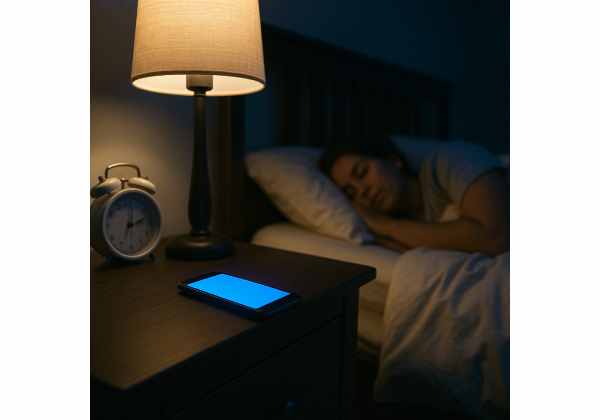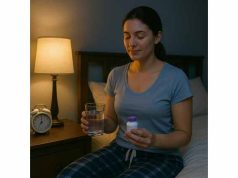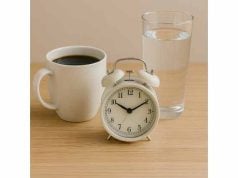
Evenings shape tomorrow’s choices. Bright screens at night delay melatonin, push bedtime later, and make mornings groggy. That single shift can raise cravings, drain willpower, and stall fat loss—even when meals look good on paper. The solution is not perfect tech hygiene; it is a practical plan for light. In this guide, you will learn how blue light affects sleep and appetite, which settings actually help, and the simplest way to use filters, night mode, and room lighting without becoming rigid. If you are building broader skills—sleep, stress, and daily habits—start with our foundation on habits, sleep and stress basics, then apply the steps below tonight.
Table of Contents
- Does blue light hurt weight loss?
- How to use night mode
- Which screens matter most
- Common mistakes and fixes
- Who should be careful
- Evidence and what to expect
- Settings and home lighting checklist
- Frequently Asked Questions
Does blue light hurt weight loss?
Short answer: indirectly, yes. Bright, short-wavelength (“blue-rich”) light in the evening delays melatonin and shifts your internal clock later. When bedtime drifts, you get less sleep or lower-quality sleep. The next day you feel hungrier, crave fast energy, and rely more on convenience foods. That pattern—late nights, short sleep, and morning fatigue—drives higher calorie intake and makes it harder to stick to the plan you set when well rested.
Here is how evening light undercuts progress:
- Appetite and cravings: Poor sleep increases hunger and the pull toward high-calorie snacks, especially at night.
- Impulse control: Tired brains negotiate: “I will start tomorrow.” Good sleep protects follow-through.
- Timing of calories: Late bedtimes push meals later. Large, late dinners plus screens increase reflux and next-day sluggishness.
- Training and movement: Sleep powers recovery. When it is short or fragmented, workouts feel harder and steps fall.
But blue light is not the villain all day. Morning and midday daylight strengthen your body clock, improve mood, and make falling asleep easier at night. The goal is timing, not total avoidance: more daylight early, less blue-rich light late.
Where to start tonight:
- Set night mode (warm tint) on all devices from one hour before lights out until morning.
- Dim room lights after dinner and use lamps instead of bright overheads.
- Keep screens out of bed; read paper or e-ink for the last 20 minutes.
- Anchor your wake time and get morning daylight for 5–10 minutes.
For safe calorie targets, plate structure, and expected rates of loss to pair with better sleep and screen habits, review our concise guide to safe weight loss basics.
How to use night mode
Night mode (or “Night Shift,” “Night Light,” “Eye Comfort”) warms screen color and often reduces overall brightness. That combination lowers the alerting effect of evening screen use so your brain can wind down on schedule. It is not a magic shield; content and timing still matter. Use the settings below as your default so you do not rely on willpower at 10 p.m.
Phone and tablet (iOS, iPadOS)
- Settings → Display & Brightness → Night Shift
- Schedule: Sunset to sunrise (best) or custom (e.g., 21:00–07:00).
- Color temperature: Slide to warmer.
- Reduce White Point: Settings → Accessibility → Display & Text Size → Reduce White Point (~10–25%).
- Auto-Lock: Shorten to 2–3 minutes to curb idle glow.
Android (varies by device)
- Settings → Display → Night Light
- Schedule: Sunset to sunrise or custom evening window.
- Intensity: Increase warmth as tolerated.
- Extra dim (where available) for a late-night brightness cap.
Windows 10/11
- Settings → System → Display → Night light
- Schedule: Sunset to sunrise, or set hours.
- Strength: Increase to a comfortable warm tone.
- Create a power plan that dims the screen and sleeps the display earlier at night.
macOS
- System Settings → Displays → Night Shift
- Schedule: Sunset to sunrise.
- Color temperature: More warm.
- Accessibility → Display → Reduce motion/Increase contrast (optional calming tweaks).
TVs and streaming boxes
- Lower Backlight/Brightness in the picture menu after sunset.
- Use Warm color preset at night.
- Enable Ambient light sensing or Eco modes to auto-dim in dark rooms.
E-readers
- Turn on warm light in the evening. Prefer e-ink over LCD for the last 20–30 minutes.
Timing rules that work
- Night mode is on by default after dinner.
- Last hour before bed: switch to print, audio, or e-ink.
- Keep screens out of bed; if you must use one, set brightness to minimum and keep the device at least 40–50 cm from your eyes.
For a broader evening routine that stacks with night mode—kitchen closed, warm shower, gentle reading—see practical steps in our guide to a simple bedtime routine.
Which screens matter most
Not all screens—and not all light—affect you equally. The dose (brightness × duration), distance from your eyes, and content (how stimulating it is) determine how much your sleep timing shifts.
Highest impact on sleep timing
- Phones up close in a dark room: High pixel density and short distance increase retinal light exposure.
- Large, bright TVs in dark rooms: Big surface area plus cinematic scenes keep arousal high.
- Laptops on the couch at max brightness: Work or gaming near bedtime prolongs alertness.
Moderate impact
- Tablets at arm’s length with night mode: Better if brightness is low and content is calm.
- Desktop monitors with warm tint: Okay earlier in the evening; still dim after dinner.
Lower impact
- E-ink readers with warm front-light: Minimal stimulation; good for the last 20–30 minutes before lights out.
- Audio books or podcasts: Eyes closed, room dark—ideal for wind-down.
Room lighting multiplies the effect
Even with night mode on, bright overhead LEDs can keep your brain “on.” The fix is simple: after dinner, use lamps at eye-level with warm bulbs (2700 K or lower), and dim the room overall. Avoid doing dishes or chores under bright task lighting right before bed.
Content still counts
Fast-cut shows, urgent news, and high-stakes gaming spike arousal. Calm content (nature, slow fiction, light comedies) is gentler on your nervous system. If you must watch, end the intense episode earlier and finish with something slower.
Morning is the opposite
Get outdoor light within an hour of waking, even if it is cloudy. Five to ten minutes anchors your clock, improves mood, and makes it easier to feel sleepy at night. For easy ways to pair light with movement, try elements from a simple morning routine.
Practical hierarchy for busy nights
- Dim the room. 2) Turn on night mode. 3) Keep the screen farther away. 4) Choose calmer content. 5) End screens 45–60 minutes before bed.
Small changes in brightness, distance, and content add up to earlier sleep and fewer late-night calories.
Common mistakes and fixes
Mistake: Relying on glasses alone
Orange or “blue-blocker” lenses help, but bright overheads and stimulating content still delay sleep.
Fix: Combine room dimming + night mode + calmer content. Glasses are a supplement, not the plan.
Mistake: Dark mode solves everything
Dark themes reduce glare, not circadian impact.
Fix: Use night mode (warmer color) and lower brightness, then cap screen time in the last hour.
Mistake: Doomscrolling in bed
The bed becomes a wakefulness cue.
Fix: Keep the phone off the nightstand. Read paper or e-ink for ten minutes; if awake longer than ~20 minutes, get up briefly and do a calm activity in dim light.
Mistake: Bright kitchen after 10 p.m.
Late chores under strong light reset your clock and trigger snacking.
Fix: Run dishes earlier. If you must clean late, use a single lamp instead of overheads.
Mistake: Late caffeine plus screens
The combo keeps you wired.
Fix: Set a caffeine cutoff 8+ hours before bed and avoid high-arousal media late.
Mistake: “I ruined today, so who cares?”
One late night becomes three.
Fix: Run a reset the next morning: outdoor light, protein at breakfast, and a short walk after lunch and dinner. For pantry raids fueled by fatigue, keep pragmatic tools from late-night snacking close.
Mistake: Overcorrecting with total tech bans
Rigid rules break on real weeks.
Fix: Use a default plan (night mode + dim room + calmer content), then end screens the last hour most nights.
Progress depends on totals—more calm evenings than chaotic ones—not perfection.
Who should be careful
Light strategies are safe for most, but some situations need extra care or tailored plans.
- Insomnia disorder: Over-focusing on rules can increase anxiety. Consider CBT-I with a professional. Keep your wind-down simple and protect consistent wake time.
- Seasonal affective symptoms or low mood: Do not over-restrict light. Prioritize morning daylight and consider discussing bright-light therapy with a clinician.
- Shift workers: Anchor to your current wake time. Use blackout curtains and a fixed wind-down sequence, even if your “night” is morning.
- Migraine or light sensitivity: Reduce contrast and brightness, and spread light sources (multiple lamps) to avoid glare.
- Suspected sleep apnea: Blue-light changes will not fix airway obstruction. If you snore loudly, gasp at night, or wake with headaches, review signs and next steps in sleep apnea basics and seek evaluation.
- Kids and teens: Warm screens and earlier dimming help, but growth and school schedules matter. Keep devices out of bedrooms overnight.
- Mental health treatment: Coordinate light timing with your care team, especially if you use light therapy or medications that affect sleep.
Rule of thumb: more daylight early, less bright light late. If sleep stays poor despite two to three weeks of consistent routines, talk with your clinician.
Evidence and what to expect
Evening blue-rich light delays melatonin and pushes the sleep phase later. Morning daylight does the opposite: it advances your clock and strengthens circadian rhythm. Stronger rhythms make falling asleep easier, deepen sleep, and stabilize energy and appetite the next day. Those changes indirectly support a calorie deficit by improving food choices, reducing cravings, and keeping training consistent.
What usually changes first
- Week 1: Bedtime becomes more predictable; you feel a bit sleepier at the desired time. Late-night snacking dips because the last hour is calmer and dimmer.
- Weeks 2–4: Fewer awakenings, earlier sleep onset, and steadier mornings. You notice better control at lunch and fewer “I need sugar” moments.
- Months 2–3: Light habits feel automatic. You rely less on willpower and more on structure.
How this supports fat loss
- Better sleep aligns hunger and fullness cues, making portions easier to manage.
- Energy and mood improve, so steps and workouts happen more often.
- Late-night calories fall, protecting your weekly deficit without strict rules.
If results stall
- Verify the basics: night mode, dim rooms after dinner, screens down in the last hour, and morning light.
- Tighten dinner timing (finish 3–4 hours before bed) and caffeine cutoff.
- Pair light changes with steady sleep duration (aim for 7–9 hours). For context on how much sleep most adults need, scan the essentials on sleep targets.
Light is leverage. It sets the stage for the behaviors that change body composition over months, not days.
Settings and home lighting checklist
Use this quick setup once, then let automation work for you.
Device automation (5 minutes each)
- Turn on night mode from one hour before bed to morning on every device.
- Set Do Not Disturb for the same window.
- Reduce maximum brightness at night (Auto-Brightness on; Extra Dim where available).
- Put phones on charge outside the bedroom or in a drawer.
Room by room after sunset
- Living room: Use two lamps at eye level with 2700 K (warm) bulbs. Keep overheads off.
- Kitchen: One under-cabinet or corner lamp if you need light after dinner; avoid bright ceiling panels late.
- Bedroom: Blackout curtains or an eye mask; small warm bedside lamp; cool room temperature.
- Bathroom: Install a low-lumens night light for late visits instead of the main light.
Wind-down hour structure
- Dim lights, switch to lamps.
- Night mode engages automatically.
- Finish screens and move to paper, audio, or e-ink.
- Warm shower, then read a few pages.
- Lights out at your target time; wake time consistent daily.
Travel or guests
- Pack a clip-on warm light and an eye mask.
- Use device night mode and download an audio book for the last 20 minutes.
Weekly review (five minutes)
- Did screens actually end in the last hour?
- Did you get 5–10 minutes of daylight within an hour of waking most days?
- Pick one tweak for the coming week.
For an integrated evening plan—meals, timing, and wind-down—pair this checklist with the simple sequence in our bedtime routine guide.
Frequently Asked Questions
Does blue light at night really affect weight loss?
Blue-rich light in the evening delays melatonin and pushes bedtime later. Shorter or fragmented sleep increases cravings and lowers restraint, which nudges calorie intake upward. Using night mode, dimming rooms after dinner, and stopping screens the last hour reduces spillover calories and protects progress.
Are blue-light blocking glasses enough?
They help, but they are not a complete solution. Bright overhead lights and stimulating content still delay sleep. Combine glasses with warmer screens, lower brightness, dimmer rooms after dinner, and calmer content. End screens the last hour and prioritize morning daylight to anchor your clock.
What night mode settings should I use?
Schedule night mode from one hour before bed until morning, choose a warmer color temperature, and reduce overall brightness. Add Do Not Disturb and automatic dimming at night. Finish with paper, audio, or e-ink in the final twenty minutes to let sleep pressure build.
Which devices are worst before bed?
Phones close to your eyes in a dark room and bright TVs with fast-paced content have the biggest impact. Laptops at high brightness are next. E-ink readers with warm front lights are gentler. Distance, brightness, and stimulation level matter as much as the device type.
How do I balance evening screens with real life?
Automate what you can: night mode, dim lamps after dinner, and a recurring wind-down reminder. Choose calmer content, keep screens out of bed, and set an earlier cutoff on nights you need more sleep. Morning daylight and a steady wake time make evenings easier.
Can morning light really improve sleep?
Yes. Five to ten minutes of outdoor light within an hour of waking strengthens your body clock, making it easier to feel sleepy at night. Morning light also boosts mood and energy, which supports better food choices and more consistent movement during the day.
References
- Recommendations for daytime, evening, and nighttime indoor light exposure to best support physiology, sleep, and wakefulness in healthy adults 2022 (Guideline)
- Effect of Sleep Extension on Objectively Assessed Energy Intake Among Adults With Overweight in Real-life Settings: A Randomized Clinical Trial 2022 (RCT)
- Blue-light filtering spectacle lenses for visual performance, sleep, and macular health in adults 2023 (Systematic Review)
- Evening use of light-emitting eReaders negatively affects sleep, circadian timing, and next-morning alertness 2015 (RCT; seminal)
- Electronic Media Use and Sleep Quality: Updated Systematic Review and Meta-Analysis 2024 (Systematic Review)
Disclaimer
This article is educational and is not a substitute for personalized medical advice, diagnosis, or treatment. Speak with your clinician about persistent sleep problems, suspected sleep apnea, insomnia, mood changes, or if you plan to use light therapy or supplements.
Share and Follow
If this guide helped, consider sharing it with a friend who wants calmer evenings and better progress. For steady, practical tools you can use right away, follow us on Facebook, X, or whichever social platform you prefer.










